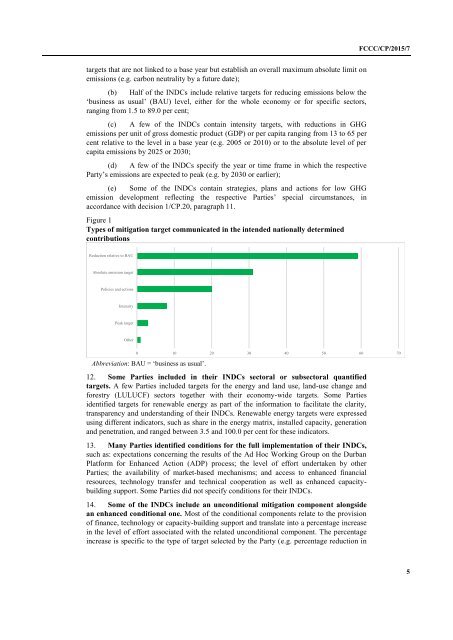FCCC/CP/2015/7
1PYuHQM
1PYuHQM
You also want an ePaper? Increase the reach of your titles
YUMPU automatically turns print PDFs into web optimized ePapers that Google loves.
<strong>FCCC</strong>/<strong>CP</strong>/<strong>2015</strong>/7<br />
targets that are not linked to a base year but establish an overall maximum absolute limit on<br />
emissions (e.g. carbon neutrality by a future date);<br />
(b) Half of the INDCs include relative targets for reducing emissions below the<br />
‘business as usual’ (BAU) level, either for the whole economy or for specific sectors,<br />
ranging from 1.5 to 89.0 per cent;<br />
(c) A few of the INDCs contain intensity targets, with reductions in GHG<br />
emissions per unit of gross domestic product (GDP) or per capita ranging from 13 to 65 per<br />
cent relative to the level in a base year (e.g. 2005 or 2010) or to the absolute level of per<br />
capita emissions by 2025 or 2030;<br />
(d) A few of the INDCs specify the year or time frame in which the respective<br />
Party’s emissions are expected to peak (e.g. by 2030 or earlier);<br />
(e) Some of the INDCs contain strategies, plans and actions for low GHG<br />
emission development reflecting the respective Parties’ special circumstances, in<br />
accordance with decision 1/<strong>CP</strong>.20, paragraph 11.<br />
Figure 1<br />
Types of mitigation target communicated in the intended nationally determined<br />
contributions<br />
Reduction relative to BAU<br />
Absolute emission target<br />
Policies and actions<br />
Intensity<br />
Peak target<br />
Other<br />
0 10 20 30 40 50 60 70<br />
Abbreviation: BAU = ‘business as usual’.<br />
12. Some Parties included in their INDCs sectoral or subsectoral quantified<br />
targets. A few Parties included targets for the energy and land use, land-use change and<br />
forestry (LULUCF) sectors together with their economy-wide targets. Some Parties<br />
identified targets for renewable energy as part of the information to facilitate the clarity,<br />
transparency and understanding of their INDCs. Renewable energy targets were expressed<br />
using different indicators, such as share in the energy matrix, installed capacity, generation<br />
and penetration, and ranged between 3.5 and 100.0 per cent for these indicators.<br />
13. Many Parties identified conditions for the full implementation of their INDCs,<br />
such as: expectations concerning the results of the Ad Hoc Working Group on the Durban<br />
Platform for Enhanced Action (ADP) process; the level of effort undertaken by other<br />
Parties; the availability of market-based mechanisms; and access to enhanced financial<br />
resources, technology transfer and technical cooperation as well as enhanced capacitybuilding<br />
support. Some Parties did not specify conditions for their INDCs.<br />
14. Some of the INDCs include an unconditional mitigation component alongside<br />
an enhanced conditional one. Most of the conditional components relate to the provision<br />
of finance, technology or capacity-building support and translate into a percentage increase<br />
in the level of effort associated with the related unconditional component. The percentage<br />
increase is specific to the type of target selected by the Party (e.g. percentage reduction in<br />
5


